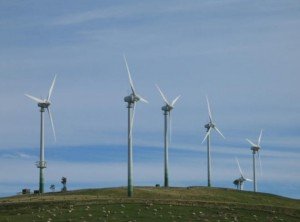The turbulence created by power-generating wind turbines may have an impact on local climate, suggests new research.
 A new study published in the journal Nature Climate Change has identified a link between wind farms and slightly increased temperatures. American researchers used data from the satellite system MODIS to examine land surface temperatures near large wind farms (totaling 2,358 wind turbines) in Texas.
A new study published in the journal Nature Climate Change has identified a link between wind farms and slightly increased temperatures. American researchers used data from the satellite system MODIS to examine land surface temperatures near large wind farms (totaling 2,358 wind turbines) in Texas.
The researchers found that wind turbines appear to modify the local climate by producing a warming trend of up to 0.720C per decade, particularly at night-time. The authors of the research suggest that wind-farms influence the temperature by modifying surface-atmosphere exchanges and the transfer of energy, momentum, mass and moisture within the atmosphere.
“Given the present installed capacity and the projected installation across the world, this study draws attention to an important issue that requires further investigation”, the authors conclude.
“We need to better understand the system with observations and better describe and model the complex processes involved to predict how wind farms may affect future weather and climate.”
Our colleagues at the Australian SMC collected the following expert commentary.
Professor Steven Sherwood, co-Director of the Climate Change Research Centre at the University of New South Wales, comments:
“The result in the paper looks pretty solid to me, and shows that night-time temperatures went up by about a half a degree in the summer where the wind farm is. Daytime temperatures do not appear to be affected. This makes sense, since at night the ground becomes much cooler than the air just a few hundred meters above the surface, and the wind farms generate gentle turbulence near the ground that causes these to mix together, thus the ground doesn’t get quite as cool. This same strategy is commonly used by fruit growers (who fly helicopters over the orchards rather than windmills) to combat early morning frosts.”